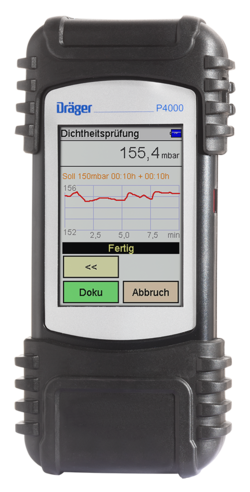Stress testing of gas pipelines:
To easily achieve perfect measurement results
When a gas pipeline is newly installed, it must be inspected according to DVGW TRGI 2018 with a load test for the security of the connections. This is followed by measurement of leak status with a leak test.
For leak testing of gas pipelines, a pressure and leak testing device is required that goes up to a minimal resolution of 0.1 bar. For dependable measurements and precise results, use the Dräger P7-TD, Dräger P7-TDX or Dräger P4000.
How is the load testing of gas pipelines carried out safely?
When load testing is done, the measurement is done of the pipeline without gas device and gas fittings. First, the gas pipeline is closed with a suitable closure.
Then, a hose is connected to the high-pressure connection to the pressure measurement device. To give the gas pipeline a test pressure of 1 bar, a second hose and a distributor block are used to connect a compression pump or a compressor.
When the test pressure is reached, the volume-dependent stabilisation phase of 10 minutes begins. Then, the load testing starts automatically and the pressure measurement device continuously displays the current pressure trend in the display.
How do I recognise a positive test result on load testing of gas pipelines?
If the end pressure remains the same as the start pressure, the correct measurement duration is maintained and no pressure drop is ascertained, the test result is positive.
After successfully concluded load testing, leak testing is carried out. This measurement is part of the everyday work of the sanitary, heating, and air conditioning professionals and heating engineers.
Questions on testing gas and water pipelines
Few industries have such high safety standards as the gas industry. The guidelines and specifications of the DVGW are accordingly stringent and call for regular inspection and control. For drinking water systems, leakproof status and hygiene must be guaranteed.
TRGI stands for the ‘Technical Regulation for Gas Installation’ (Technische Regel für Gasinstallation) and is the most important datasheet for gas installations in buildings. It contains regulations for planning, production, modification and operation of gas installations with an operating pressure of up to 1 bar in buildings and on property. Significant content for measurement technology Chapter V and Section 13 includes three different tests (lines up to 100 mbar operating pressure):
- Load test (pre-test)
- Leak detection (main testing)
- Serviceability testing (leak rate measurement)
Serviceability testing is required every 12 years for operating pipeline systems with operating pressures of up to 100 mbar. Additionally, an annual visual inspection must be carried out of the pipeline system on wall ducts.
TRF stands for ‘Technical Regulations for Liquefied Gas’ in German, comprising rules and requirements for the marketing, establishment and operation of liquefied gas systems based on applicable regulations and standards. The TRF establishes a pressure test and leak test that must be carried out immediately before commissioning. Then, a recurring leak test for lines that are in operation is prescribed.
The DIN 806-4 is a European standard that regulates the testing of drinking water systems. It contains recommendations and requirements for the installation of drinking water systems inside buildings and the installation of pipelines outside buildings. It can be used on new installations, overhauls and repairs.
The ZVSHK datasheet focuses on leak detection of drinking water systems with compressed air, inert gas or water. There are three variants for leak detection with water, depending on the active ingredient. The modified method can be used for all substances and combinations of substances. For leak detection with water, test method B as per DIN EN 806-4 applies. The test time is extended according to the current datasheet so that even the smallest leaks can be detected during the leak test. Additionally, the duration of the test method is expanded with compressed air or inert gases.
DIN EN 1610 is the basic standard for the installation and testing of sewage pipelines and tunnels. In the testing of sewage pipelines with air, the test duration depends on the test method, the substance and the pipe diameter.
Worksheet G 459/I addresses the planning and design of house connections for gas supply up to 4 bar operating pressure. Pressure testing must be carried out before commissioning according to DVGW Worksheet G 469.
Pressure testing for house connection pipelines can be carried out with the Dräger P7-TS.
